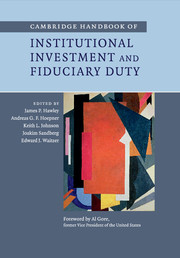Book contents
- Frontmatter
- Contents
- List of figures
- List of tables
- List of contributors
- Foreword
- 1 Introduction
- Part I Fiduciary duty: a global outlook
- 2 The public fiduciary: a Canadian perspective
- 3 The basis of fiduciary duty in investment in the United States
- 4 Governance and accountability in UK pension schemes
- 5 Institutional investment and fiduciary duty in Australia
- 6 The regulation of institutional investment in Sweden: a role model for the promotion of responsible investment?
- 7 The Dutch pension system
- Part II Fiduciary duty and the landscape of institutional investment
- Part III Challenging conventional wisdom on fiduciary duty
- Part IV Towards a broader interpretation of fiduciary duty
- Part V Beneficiaries’ roles and viewpoints
- Part VI Fiduciary duty and governance
- Index
- References
6 - The regulation of institutional investment in Sweden: a role model for the promotion of responsible investment?
Published online by Cambridge University Press: 05 April 2014
- Frontmatter
- Contents
- List of figures
- List of tables
- List of contributors
- Foreword
- 1 Introduction
- Part I Fiduciary duty: a global outlook
- 2 The public fiduciary: a Canadian perspective
- 3 The basis of fiduciary duty in investment in the United States
- 4 Governance and accountability in UK pension schemes
- 5 Institutional investment and fiduciary duty in Australia
- 6 The regulation of institutional investment in Sweden: a role model for the promotion of responsible investment?
- 7 The Dutch pension system
- Part II Fiduciary duty and the landscape of institutional investment
- Part III Challenging conventional wisdom on fiduciary duty
- Part IV Towards a broader interpretation of fiduciary duty
- Part V Beneficiaries’ roles and viewpoints
- Part VI Fiduciary duty and governance
- Index
- References
Summary
Introduction
Over the last half-century or so, the Swedish capital market has increasingly come to be dominated by large-scale institutional investors, such as pension funds, mutual funds, insurance companies and other kinds of financial organizations. Recent estimates suggest that domestic and foreign institutions control more than 85 percent of all outstanding shares on the Stockholm Stock Exchange (Skog 2005; Stattin 2010). This makes the Swedish market among those with the highest concentration of institutional ownership in the world. In this context it is interesting to note that, according to many scholars, Sweden presents a unique regulatory environment for institutional investment; an environment with unparalleled emphasis on responsible investment practices (Richardson 2008; Robins 2006; Statman 2005). Much praise has, for example, been given to the investment mandate of the national pension funds (the AP funds), which obliges them to incorporate ethical and environmental concerns into investment decisions (Hamilton and Eriksson 2011). Sweden also has a comparably well-developed market for retail mutual funds with an ethical or environmental profile, especially in relation to the limited size of the country’s total fund market (Eurosif 2012).
This chapter introduces and discusses some main features of the Swedish regulatory environment with regards to institutional investment, with special emphasis on the connection to responsible investment. We start by introducing some of the main legal statutes concerning institutional investment and compare them with the fiduciary duties imposed on trustees in other countries, such as the UK and the US. Thereafter we discuss the more specific legal framework relevant for mutual funds and pension funds, respectively, and especially discuss their mandate for engaging in responsible investment. Given the centrality of the AP funds, we then present and analyze a case study of how the AP funds developed their understanding of the government directive about taking ethical and environmental concern. Finally, we end with a discussion of to what extent the Swedish regulatory framework should be considered a role model for the promotion of responsible investment in other countries.
- Type
- Chapter
- Information
- Publisher: Cambridge University PressPrint publication year: 2014
References
- 4
- Cited by

